Try my recipe for refrigerator dill pickles (no sugar) if you want a quick pickling recipe that's sugar free. Just put your onions and cucumbers in a jar with spices, add the brine, and pop it in the fridge. You’ll also get a pickle recipe without dill option, and both fit most special diets, including low carb, keto, gluten-free, and vegan.
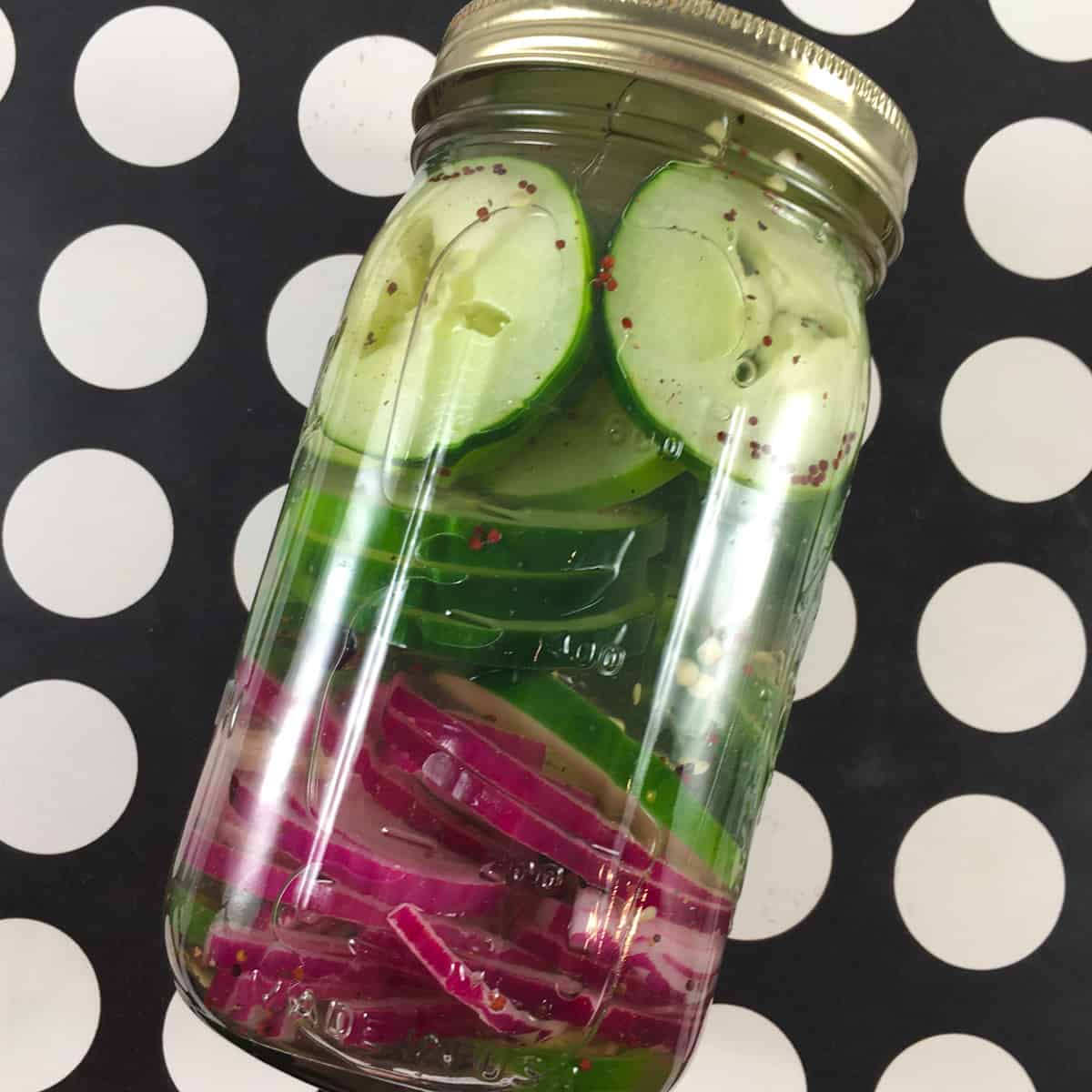
Want to save this post?
Enter your email below and we'll send it straight to your inbox. Plus you'll get great new recipes from us every week!
If you've never tried no cook refrigerator pickles before, now might be a great time. I grow cucumbers, and cucumber season is wrapping up where I live. These refrigerator pickles without sugar are the best way to use garden cucumbers.
Old fashioned cucumbers and onions in vinegar are a tasty topping for burgers, or for snacking on alone! You’ll love this recipe for sugar-free refrigerator pickles if you want an easy recipe for no boil pickles. (Don’t miss the tips on making no cook sweet pickles and dill pickles too!)
Table of Contents
🥒 Refrigerator Dill Pickles No Sugar
Here are the ingredients you need to make the best no sugar refrigerator pickles:
- 10 ounces pickling cucumbers, thinly sliced (284 grams; 1-2 cucumbers)
- 2-3 cloves garlic, smashed
- ½ medium onion, thinly sliced
- 4 fresh dill sprigs
- 1 cup white vinegar
- 3 cups water (very hot from tap)
- 1½ tablespoons finely ground sea salt
Get a printable recipe card at the end of the post!
Dried dill can also be used for no cook dill pickles, but fresh dill looks much nicer in the jars. Also, fresh dillweed doesn’t stick to the cucumbers as much. That said, you can substitute about 1 tablespoon dried dill for the fresh dill if you’d prefer.
Pickling varieties of cucumbers (such as Kirby cucumbers) are best for pickling. Small Persian cucumbers (mini cucumbers) don’t soften up as well and aren’t recommended for this recipe, but may work fine for pickle spears. English cucumbers have thinner skin than pickling cucumbers, resulting in a soggy cucumber (source).
I really like red onions for pickling cucumbers and onions. They turn the brine a lovely pink color and are a bit milder than yellow onions. Sweet onions are a nice alternative if you don’t want pink brine.
I always use white vinegar for pickles. It’s cheap and has a neutral flavor. You could substitute with white wine vinegar, red wine vinegar, apple cider vinegar, or rice vinegar if you prefer.
Does the type of salt matter when making pickles? You should use canning salt for canned pickles. For refrigerator pickle recipes, using Kosher salt or fine ground sea salt is fine.
The kitchen equipment you need for no cook refrigerated pickles includes a wide-mouth quart jar with lid (glass mason jar). You’ll also need a sharp knife or mandoline slicer to slice the vegetables.
Pickle Recipe without Dill
You could also make homemade refrigerator pickles without dill if you’d prefer. Here’s the shopping list:
- 10 ounces pickling cucumbers, thinly sliced (284 grams; 1-2 cucumbers)
- 2-3 cloves garlic, smashed
- ½ medium red onion, thinly sliced
- ½ jalapeno, sliced
- 1 teaspoon brown mustard seeds
- 1 teaspoon juniper berries
- ½ teaspoon black pepper
- 1 bay leaf
- 1 cup white vinegar
- 3 cups water (very hot from tap)
- 1½ tablespoons finely ground sea salt
You’re welcome to play around with the herbs and spices I used. Skip the juniper berries if you can’t find them, add some coriander seed, red pepper flakes for heat, etc.
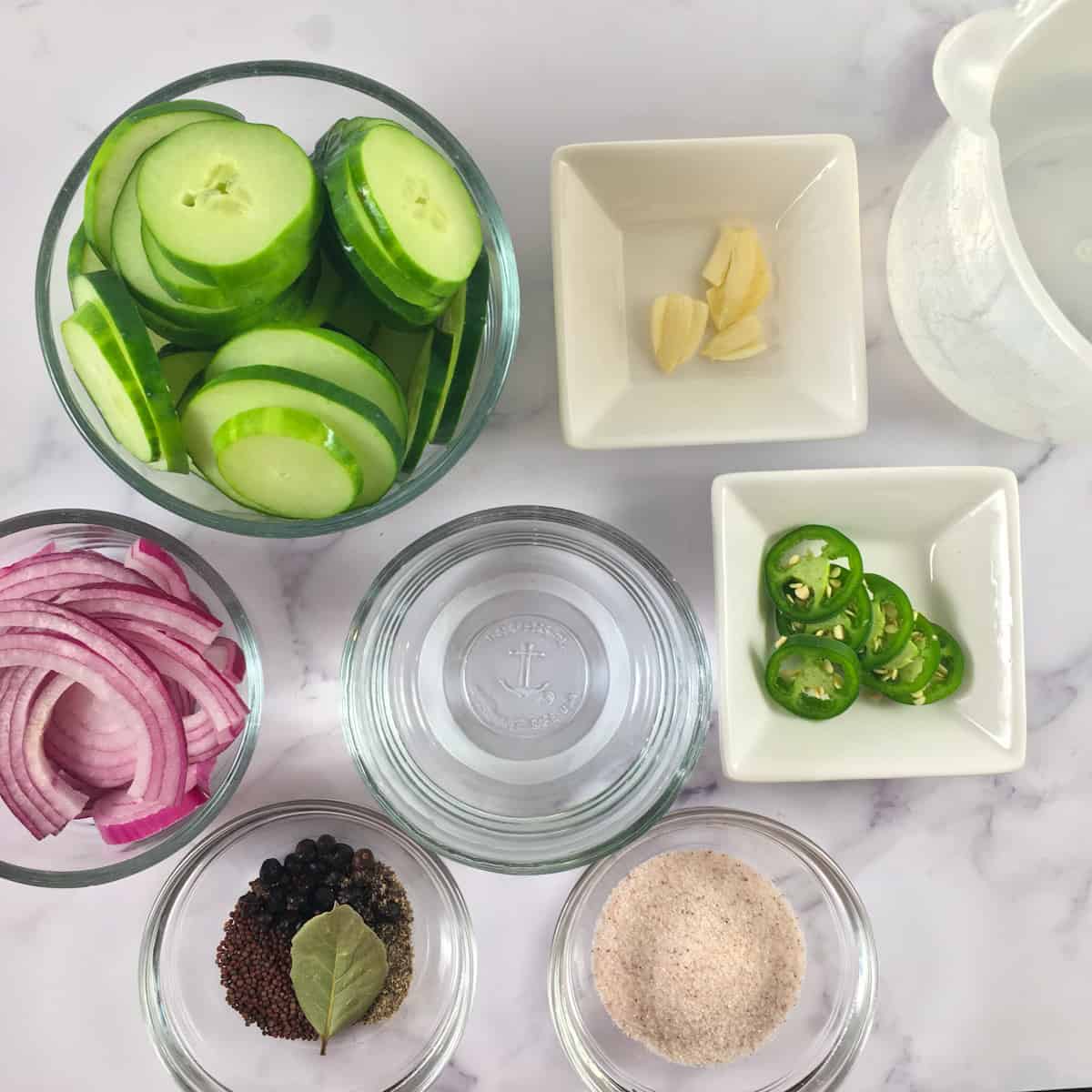
➕ How to Make Refrigerator Pickles No Sugar
Let’s make no sugar fridge pickles! Here are the step-by-step instructions:
- First, it’s important to cut the cucumbers thin since this is a no cook recipe. Don’t use whole pickles; the brine will take too long to penetrate them. Cut the cucumbers into slices that are ¼-inch (0.6 cm) thick, discarding the stem end. Cut the onion in half and slice ⅛-inch (0.3 cm) thick. Smash the garlic cloves.
- Stir the vinegar, hot water, and salt together until the salt has dissolved. Set this brine aside.
- Layer all of the other ingredients in a wide-mouth quart jar. I like to start with the herbs and spices and end with the cucumbers.
- Pour the brine over the top, filling the jar to the bottom of its neck and completely covering the cucumbers. You will not use all of the brine. Leave about 1-inch (2.54 cm) of headspace in the jar. This will give you room to shake the jar. If the jar is overpacked, you can take some veggies out (but you should not need to do this).
- Put the lid on the jar, give it a gentle shake, and refrigerate. These pickles are best after sitting in the fridge for around a week, but you can start enjoying them in 3-5 days if you're feeling impatient. Even though they’re quick pickles, they’re still a slow food.
These pickle chips are great on a sandwich or wrap!
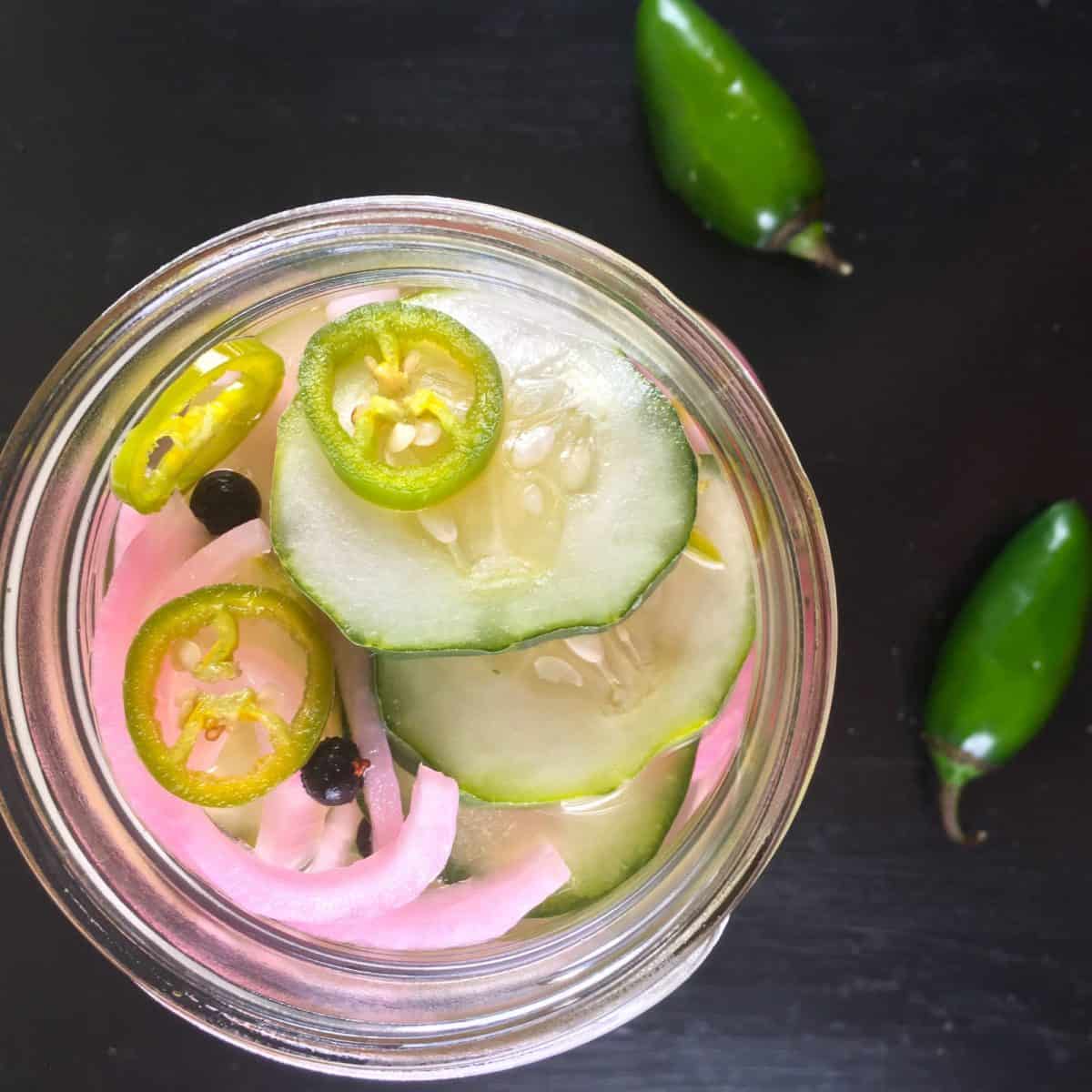
⭐ What is the difference between fridge pickles and traditional pickling?
The main difference between old fashioned refrigerator pickles and classic pickles is that fridge pickles are not canned. While properly canned pickles are shelf-stable and can be safely stored at a cool temperature for months, fridge pickles must be refrigerated. In addition, these low sugar refrigerator pickles won’t last as long (only about a month).
These no cook refrigerator pickles have a vinegar to water ratio of 1:3 and are not safe for canning. Cucumber pickle recipes that are safe for heat processing must have a higher acidity.
“Traditional pickles” is often used to refer to fermented cucumbers. Beneficial bacteria in traditionally fermented cucumber pickles have been encouraged to thrive. This gives the pickles a sour or tangy flavor and helps to preserve them.
The downside of traditional ferments is that they can take a long time to ferment (often weeks). We’re taking a shortcut with this pickled cucumber recipe. The vinegar brine gives the pickles a piquant flavor without the long fermentation.
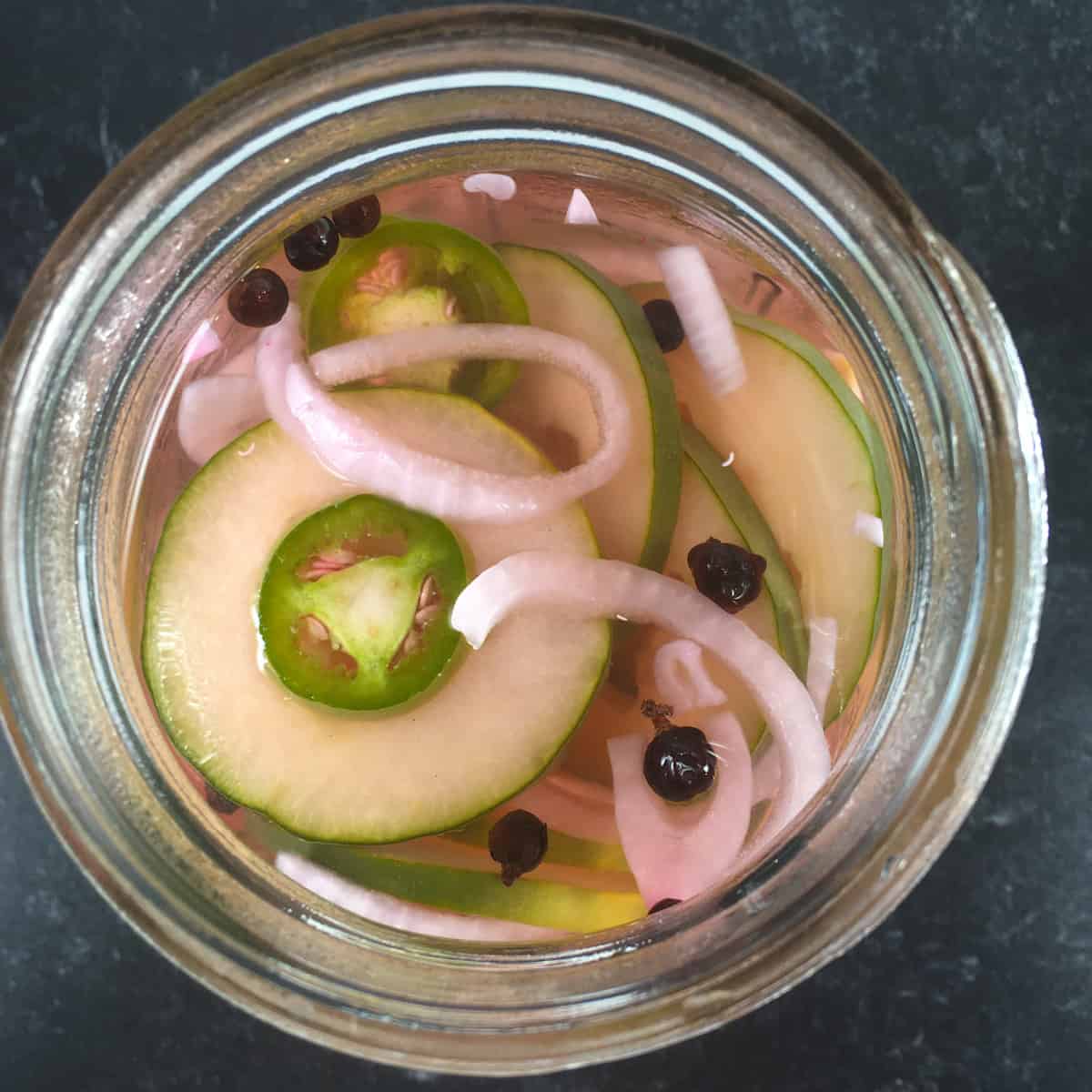
FAQs
What kind of pickles have no sugar?
Dill pickles are often made without adding sugar during the pickling process and are suitable for those who want to avoid sugar in their diet. Check the nutrition label of the pickle jar to ensure they are keto pickles.
Do dill pickles need sugar?
No, dill pickles do not require sugar in their traditional recipe. They are typically made with a brine of water, vinegar, salt, and dill spices. Sugar is not a standard ingredient in dill pickle recipes.
What is a good substitute for sugar in pickles?
A good substitute for sugar in pickles is Swerve or Lakanto monkfruit sweetener, or another 1:1 sugar replacement. This is an easy way to make no sugar refrigerator bread and butter pickles and other sweet pickles.
Do you have to use sugar in pickling?
Sugar is not a mandatory ingredient in pickling. Many pickling recipes use vinegar, salt, and various spices for flavor and preservation, without the need for sugar. However, some pickling recipes may include sugar to balance flavors or add sweetness, but it's not a universal requirement in pickling.
Do you have to boil jars for refrigerator pickles?
Since we are not canning pickles, you do not need to boil the jars to sterilize them. Regularly washing the jars (in the dishwasher or by hand) is fine for fridge pickles.
How long do refrigerator pickles last?
Homemade pickled cucumbers last for 3-4 weeks in the refrigerator. They must stay submerged in the brine to stay fresh. Do not freeze them.
How to make refrigerator pickles no vinegar?
You can make refrigerator pickles without vinegar, as Mark Bittman does in this kosher pickles recipe. Keep in mind that these pickles may not have the sharpness of cucumbers pickled in vinegar.
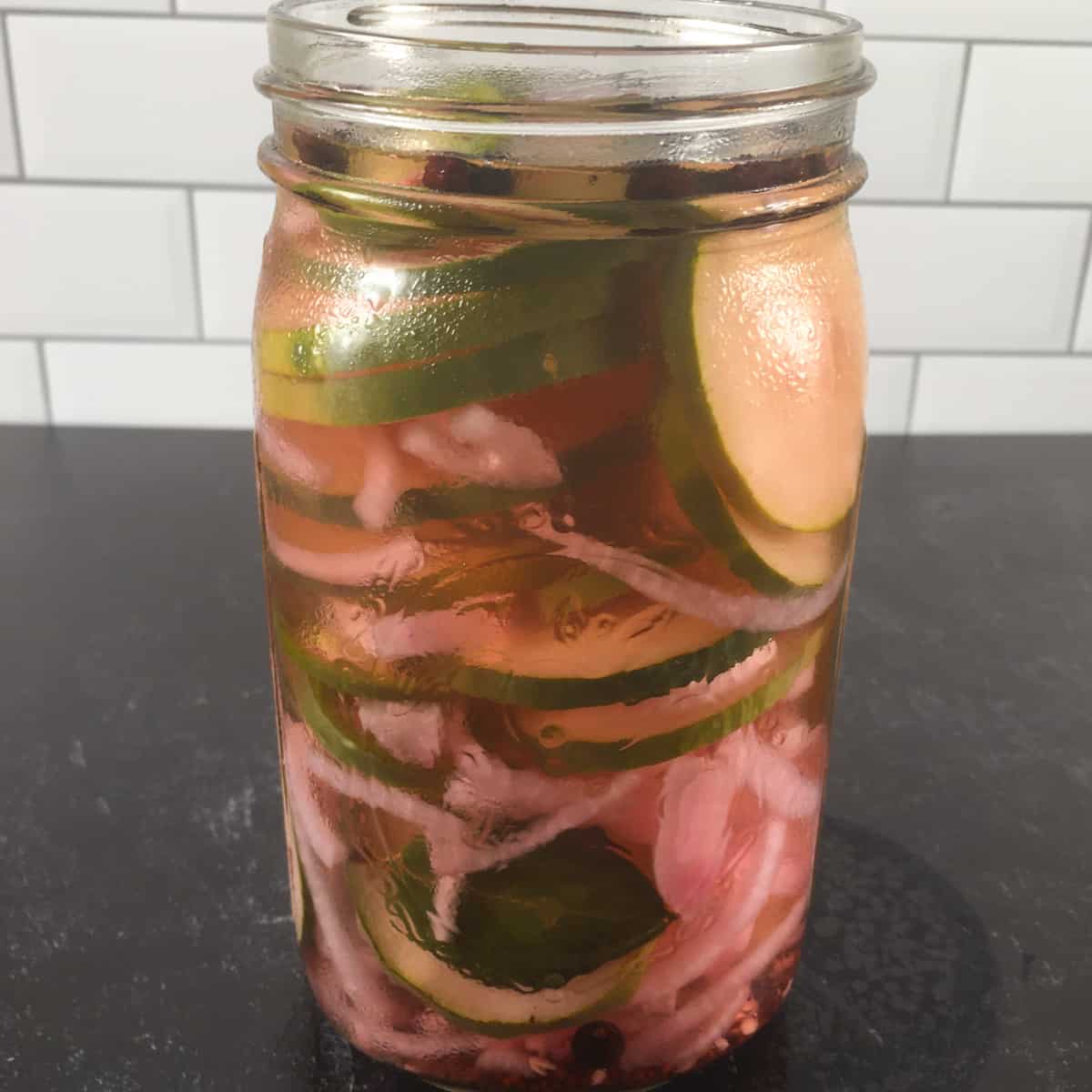
👩🏻🍳 Other Pickled Recipes
Want more recipes for pickled vegetables and fermented vegetables or fruit? Don’t miss these:
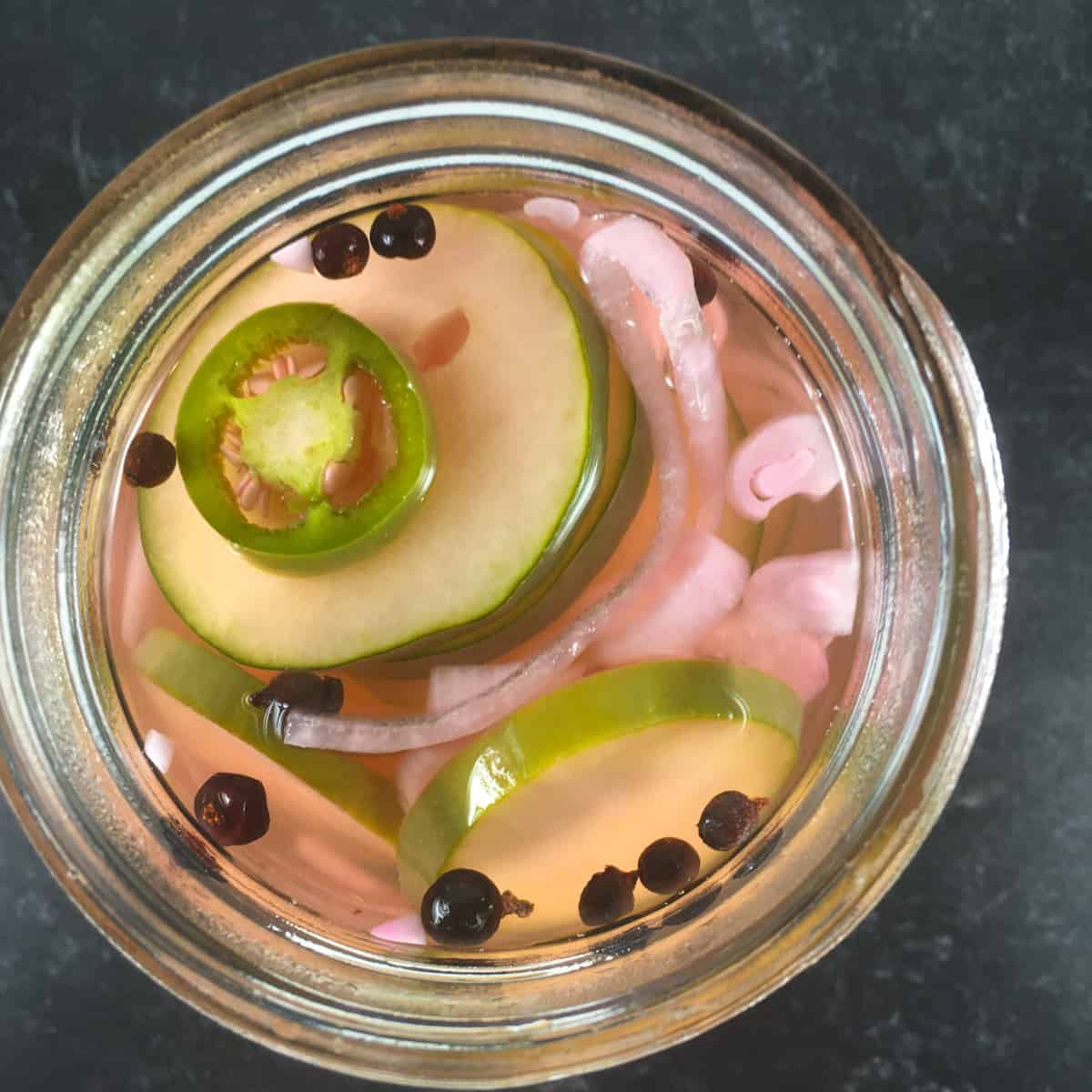
📖 Recipe Card
Watch How to Make It!
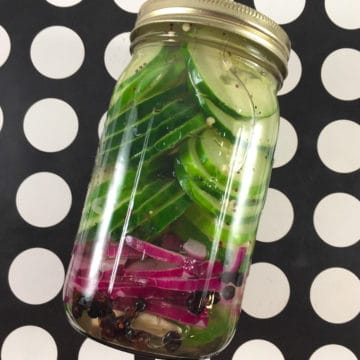
Refrigerator Dill Pickles No Sugar- Sugar Free Refrigerated Pickles
Ingredients
Refrigerator Dill Pickles (No Sugar):
- 10 ounces pickling cucumbers, thinly sliced (284 grams; 1-2 cucumbers)
- 2-3 cloves garlic, smashed
- ½ medium onion, thinly sliced
- 4 sprigs fresh dill
- 1 cup white vinegar
- 3 cups water (very hot from tap)
- 1½ tablespoons finely ground sea salt
Pickle Recipe without Dill:
- 10 ounces pickling cucumbers, thinly sliced (284 grams; 1-2 cucumbers)
- 2-3 cloves garlic, smashed
- ½ medium red onion, thinly sliced
- ½ jalapeno, sliced
- 1 teaspoon brown mustard seeds
- 1 teaspoon juniper berries
- ½ teaspoon black pepper
- 1 bay leaf
- 1 cup white vinegar
- 3 cups water (very hot from tap)
- 1½ tablespoons finely ground sea salt
Instructions
- Cut the cucumbers into slices that are ¼-inch (0.6 cm) thick, discarding the stem end. Cut the onion in half and slice ⅛-inch (0.3 cm) thick. Smash the garlic cloves.
- Stir the vinegar, hot water, and salt together until the salt has dissolved. Set this brine aside.
- Layer all of the other ingredients in a wide-mouth quart jar. I like to start with the herbs and spices and end with the cucumbers.
- Pour the brine over the top, filling the jar to the bottom of its neck and completely covering the cucumbers. You will not use all of the brine. Leave about 1-inch (2.54 cm) of headspace in the jar.
- Put the lid on the jar, give it a gentle shake, and refrigerate. These pickles are best after sitting in the fridge for around a week, but you can start enjoying them in 3-5 days if you're feeling impatient. 🙂
Equipment
Notes
💭 Expert Tips from Dietitian Summer Yule
This is a level 1 recipe (may help support fat loss). The nutrition information for this recipe excludes the brine. (Note: Though you are likely not consuming the brine, the sodium content of this recipe will be higher than listed below since the veggies do absorb some of the salt.) Cucumber pickles with no added sugar, as we have here, are an extremely low-calorie food. They fit most special diets (aside from low-sodium diets), and they add a great flavor to meals. I enjoy them as a snack as well. Cucumber pickles (though botanical fruits) count towards your non-starchy vegetable intake. Most of us in the U.S. don’t get enough veggies in our diets, so why not include some pickles? The electrolyte losses associated with very low carb and keto diets can lead to electrolyte imbalances if the diet isn’t planned well. The salt in pickled and naturally fermented veggies can help replenish sodium. Though many of us overconsume sodium, it’s also an essential mineral that is needed for good health. Most sodium in the American diet comes from ultra-processed foods and restaurant meals. If you are cooking at home and prioritizing whole foods, your diet may not be very high in sodium. Enjoying some cucumber pickles now and then is a good way to include more of this nutrient on healthy eating plans. Nutrition information is for one serving of no sugar refrigerator dill pickles and does not include the brine, herbs, and spices. Sodium content is likely an underestimate, since some brine is absorbed by the veggies.
nutrition info disclaimer
All recipes on this website may or may not be appropriate for you, depending on your medical needs and personal preferences. Consult with a registered dietitian or your physician if you need help determining the dietary pattern that may be best for you.
The nutrition information is an estimate provided as a courtesy. It will differ depending on the specific brands and ingredients that you use. Calorie information on food labels may be inaccurate, so please don't sweat the numbers too much.
"To taste" means to your preferences, which may have to be visual to follow food safety rules. Please don't eat undercooked food x
Nutrition
Join our community! Subscribe for all of the latest and greatest recipes, and follow me on Facebook, Pinterest, Instagram, and YouTube!

Hello! I'm Summer, a registered dietitian and home chef who loves to cook, eat, and create high quality content for you! Every recipe on this site has been tested by me to help ensure your success in the kitchen. All eaters are welcome here 🙂


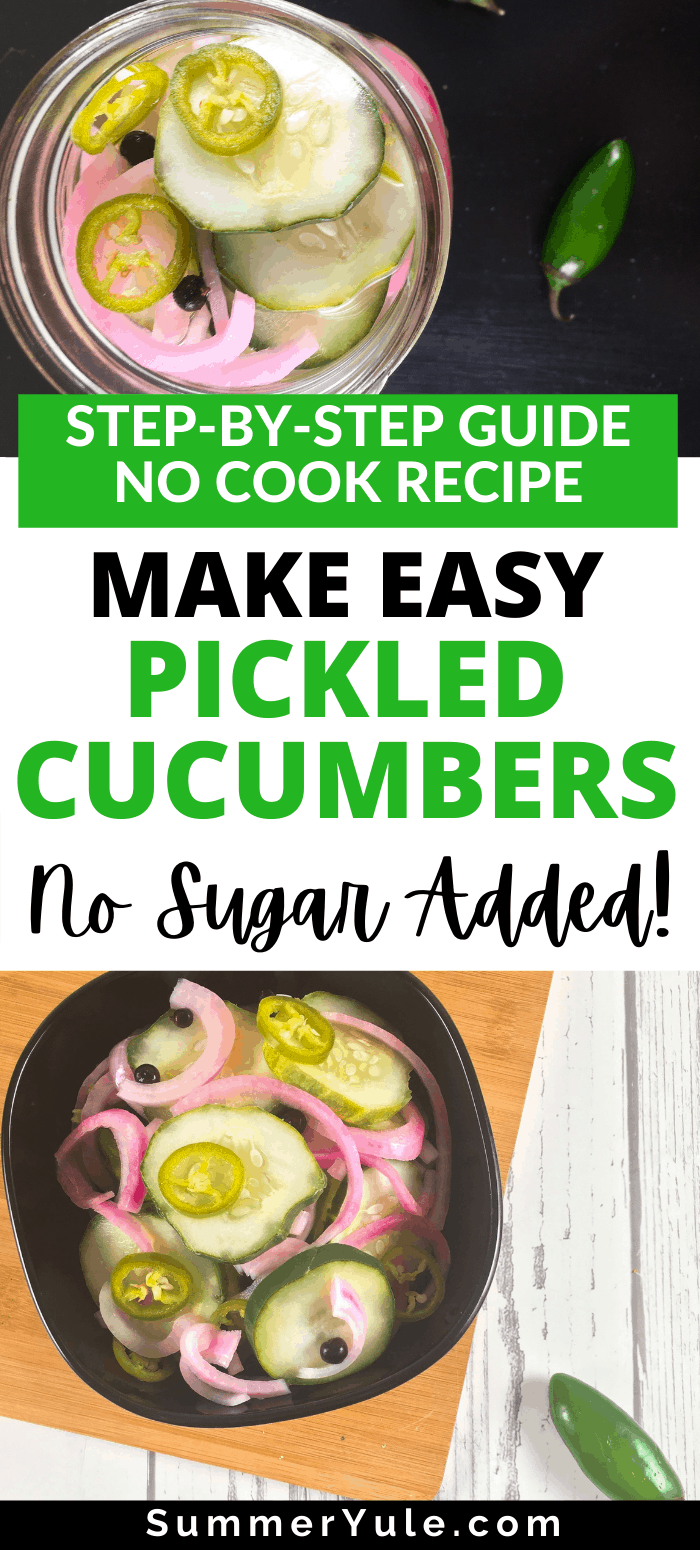
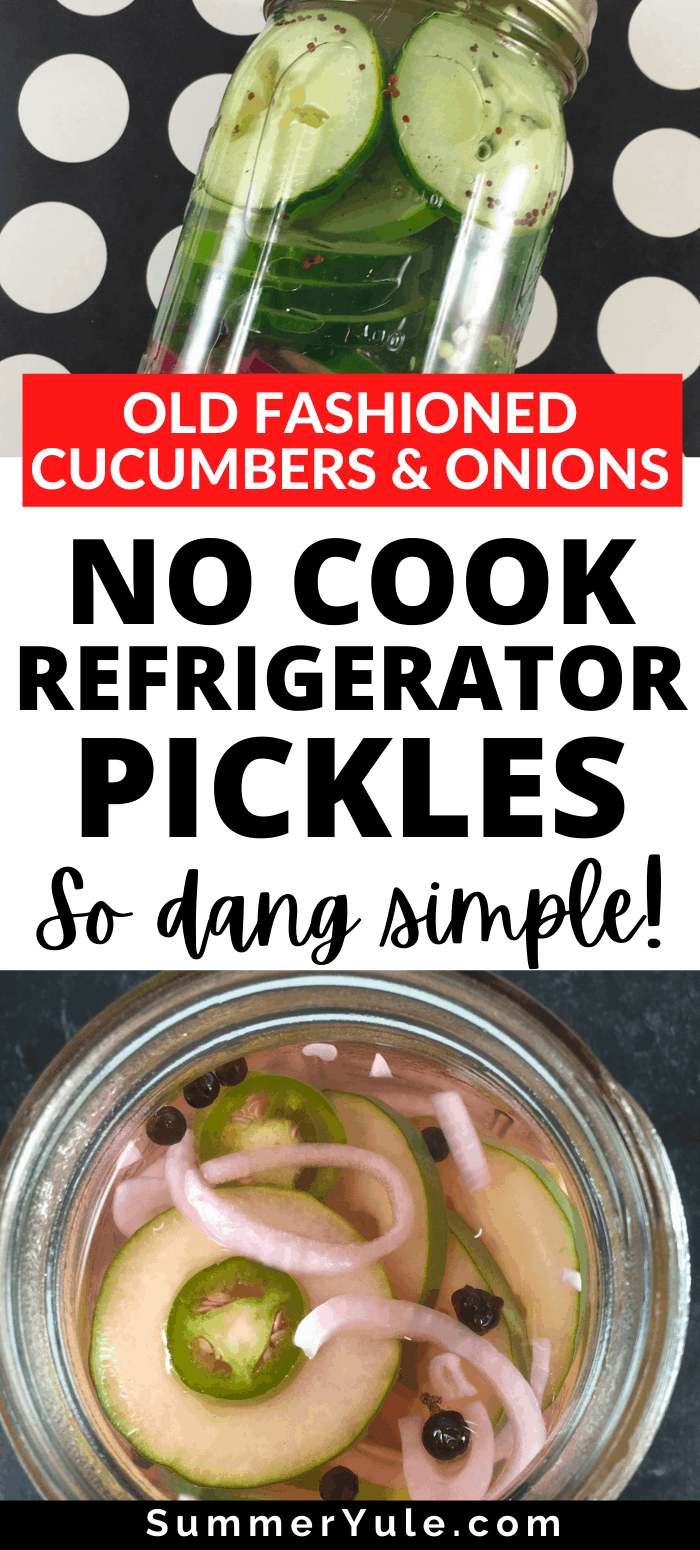
Annie says
How long can these be kept in the fridge before they go bad. Please.
Summer Yule says
Hi Annie! They last about a month. Thanks for dropping in 🙂 Summer
Jeri says
I have a question. Can I use pickling spices?
Summer Yule says
Yes, absolutely!
Terrified Amateur says
Clever way, Summer, of getting around a process I always thought turned the kitchen into a sauna for a day.
Of course, my last direct experience was many years ago, as a kid, when my parents grew pickling cucumbers. Of course, the vines were at peak production when the season also was at full subtropical force. I remember big stockpots full of water boiling away on the stovetop all day.
Sure, we had a year's supply of homemade pickles after that, and they were so amazing, but I still don't know if was entirely worth accompanying Dante on his tour of the seven rings. Your innovation, though, gets around that ordeal. Well-played, Summer!
Summer Yule says
Where you are, I bet you have access to a lot of great pickled veggies. I've come to associate Pennsylvania Dutch cuisine with delicious chow-chow and other yummy preserved items in that category. In your case, you may be able to get some excellent homemade pickles locally without this recipe or heating up the house! When we lived in central upstate NY, the Amish would sell delicious homemade foods at the farmer's markets. Unfortunately, they don't seem to come to the markets in our current neck of the woods!